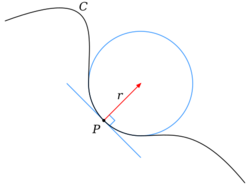Osculating curve
In differential geometry, an osculating curve is a plane curve from a given family that has the highest possible order of contact with another curve. That is, if F is a family of smooth curves, C is a smooth curve (not in general belonging to F), and P is a point on C, then an osculating curve from F at P is a curve from F that passes through P and has as many of its derivatives at P equal to the derivatives of C as possible.[1][2]
The term derives from the Latinate root "osculate", to kiss, because the two curves contact one another in a more intimate way than simple tangency.[3]
Examples
Examples of osculating curves of different orders include:
- The tangent line to a curve C at a point p, the osculating curve from the family of straight lines. The tangent line shares its first derivative (slope) with C and therefore has first-order contact with C.[1][2][4]
- The osculating circle to C at p, the osculating curve from the family of circles. The osculating circle shares both its first and second derivatives (equivalently, its slope and curvature) with C.[1][2][4]
- The osculating parabola to C at p, the osculating curve from the family of parabolas, has third order contact with C.[2][4]
- The osculating conic to C at p, the osculating curve from the family of conic sections, has fourth order contact with C.[2][4]
Generalizations
The concept of osculation can be generalized to higher-dimensional spaces, and to objects that are not curves within those spaces. For instance an osculating plane to a space curve is a plane that has second-order contact with the curve. This is as high an order as is possible in the general case.[5]
In one dimension, analytic curves are said to osculate at a point if they share the first three terms of their Taylor expansion about that point. This concept can be generalized to superosculation, in which two curves share more than the first three terms of their Taylor expansion.
See also
References
- ↑ 1.0 1.1 1.2 Rutter, J. W. (2000), Geometry of Curves, CRC Press, pp. 174–175, ISBN 9781584881667, https://books.google.com/books?id=YlLpO8Sv8RMC&pg=PA174.
- ↑ 2.0 2.1 2.2 2.3 2.4 Williamson, Benjamin (1912), An elementary treatise on the differential calculus: containing the theory of plane curves, with numerous examples, Longmans, Green, p. 309, https://books.google.com/books?id=7ZlUAAAAYAAJ&pg=PA309.
- ↑ Max, Black (1954–1955), "Metaphor", Proceedings of the Aristotelian Society, New Series 55: 273–294. Reprinted in Johnson, Mark, ed. (1981), Philosophical Perspectives on Metaphor, University of Minnesota Press, pp. 63–82, ISBN 9780816657971. P. 69: "Osculating curves don't kiss for long, and quickly revert to a more prosaic mathematical contact."
- ↑ 4.0 4.1 4.2 4.3 Taylor, James Morford (1898), Elements of the Differential and Integral Calculus: With Examples and Applications, Ginn & Company, pp. 109–110, https://books.google.com/books?id=di0AAAAAYAAJ&pg=PA109.
- ↑ Kreyszig, Erwin (1991), Differential Geometry, Toronto University Mathematical Expositions, 11, Courier Dover Publications, pp. 32–33, ISBN 9780486667218, https://books.google.com/books?id=P73DrhE9F0QC&pg=PA32.
 |


